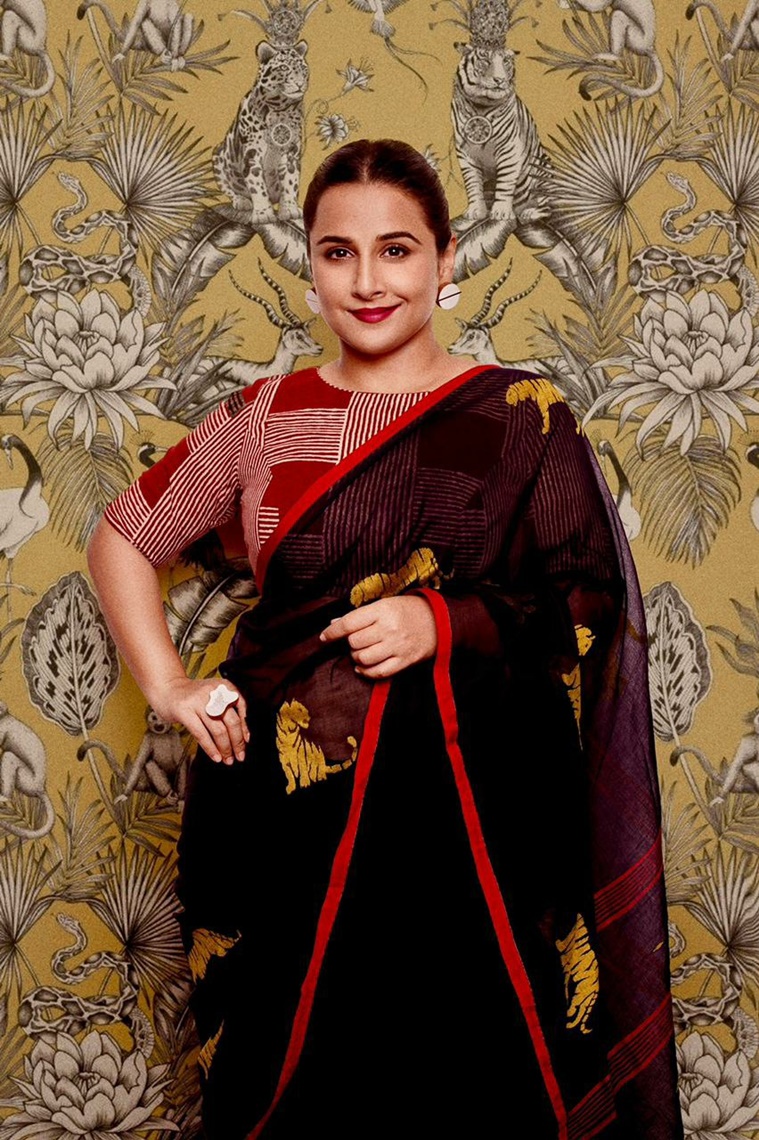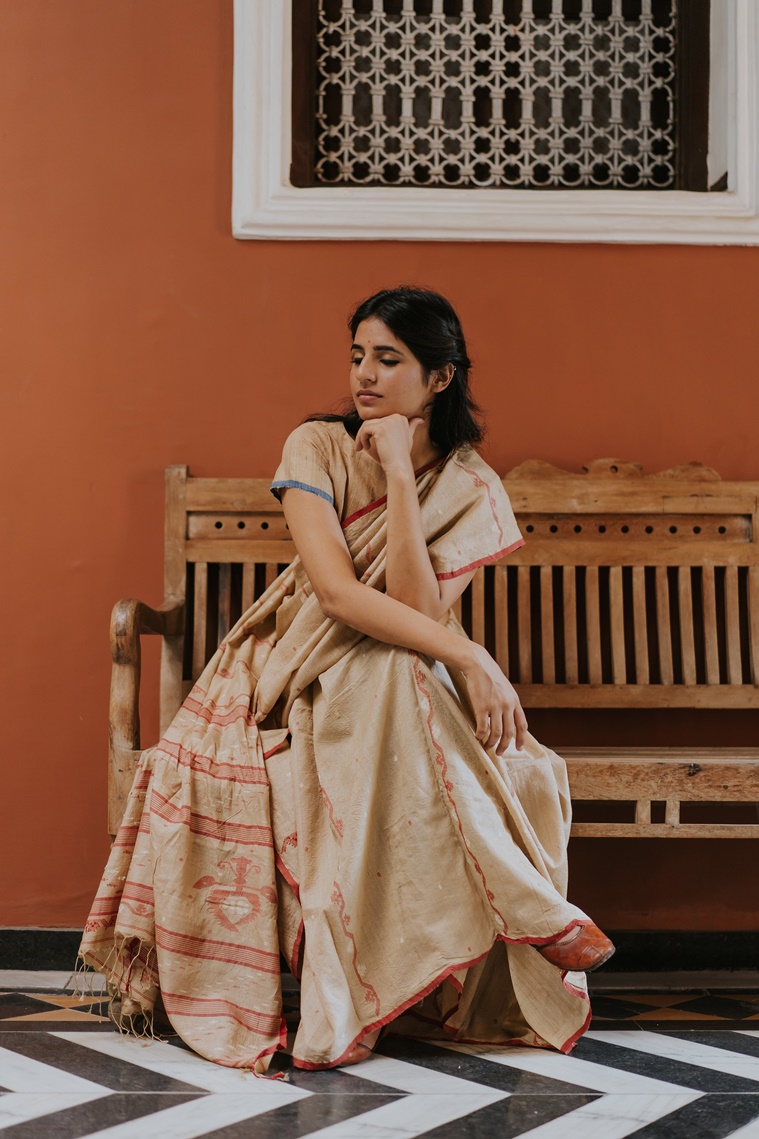 Azmeri Haque Badhon from Cannes in a Dhakai Jamdani. (Photo: Azmeri Haque Badhon)
Azmeri Haque Badhon from Cannes in a Dhakai Jamdani. (Photo: Azmeri Haque Badhon) Last month, at the 74th Cannes Film Festival, when Bangladeshi actor Azmeri Haque Badhon walked the red carpet at the screening of her film Rehana Maryam Noor, what stood out was her attire for the occasion. Amid a sea of gowns and dresses, Haque’s beige-olive half-silk sari with gold threadwork on it was a hat tip to South Asia and to a craft form unique to the subcontinent — the Jamdani. In 2011, Indian Bengali actor Paoli Dam had walked the red carpet, too, in a red-and-white Dhakai Jamdani when her film Chhatrak had travelled to the French Riviera.
Designed by Bangladeshi fashion conglomerate Aarong, the 100-thread count sari threw open discussions on the attractive possibilities of the Jamdani at a global stage and also the old debate on who the Jamdani really belongs to — India or Bangladesh. After all, while India holds the Geographical Indication (GI) tag for the Uppada Jamdani, Bangladesh has the GI tag for the Jamdani. “I love the sari and I feel completely at ease in it. As the first actor to officially represent Bangladesh on the red carpet at Cannes, I wanted to be true to myself and to my roots. And, what could be more befitting than a Jamdani sari that speaks of our heritage?” says the actor.
What is Jamdani?
In its truest form, Jamdani denotes muslin, a fine cotton fabric, with geometric or floral motifs woven on handlooms by artisans traditionally based in villages such as Rupganj, Narayanganj, and Sonargaon around Bangladesh’s capital Dhaka. Sonargaon, in particular, located at the confluence of three rivers — Meghna, Brahmaputra and Sitalakhya — was well-known for producing some of the finest cotton in the world, including the muslin once synonymous with the Jamdani, along its fertile estuarine banks. “Though weaving was done by Muslims, most of the spinning was done by Hindu women,” says Bangladeshi textile revivalist Saiful Islam, who has been working to revive muslin in the country for nearly a decade. The weaving techniques were passed down generations through an oral tradition of instructions woven into songs, making each weaving cluster exclusive repositories of craft techniques.
It was the advent of Mughals that raised an already flourishing trade into an art form and gave the Jamdani its name. “Muslin, the legendary ‘woven air’ of Bengal, had five principle varieties, of which the jamdani (‘vase of flowers’ in Farsi) was one of them; the most expensive and intricate one. It was woven from phuti karpas, a particular variety of cotton grown on the banks of the river Meghna in Bangladesh. Extremely high count yarn (above 250) was used for its weaving on the looms of Bengal. There is no clear date of its origin, though there is mention of this term (muslin) in a variety of sources, including Kautilya’s Arthashashtra (3rd century BC) and the Gupta period (4th – 6th century AD). It reached its apex during the Mughal rule (16th-18th centuries). It is also believed that during this period, the development of the jamdani motifs occurred due to Persian influence along with the removal of human figures from the designs,” says Islam.
 Vidya Balan in tiger-motif Jamdani by Ghuri by Debjani. (Photo: Ghuri by Debjani)
Vidya Balan in tiger-motif Jamdani by Ghuri by Debjani. (Photo: Ghuri by Debjani)
The technique
In Descriptive and Historical Account of the Cotton Manufacture of Dacca in Bengal (John Mortimer, 1851), the process of weaving Jamdani is described: “In manufacturing figured (jamdani) fabrics, two weavers sit at the loom. They place the pattern, drawn upon paper, below the warp, and range along the track of the woof a number of cut threads equal to the flowers or parts of the design intended to be made; and then, with two small fine-pointed bamboo sticks, they draw each of these threads between as many threads of the warp as may be equal to the width of the figure which is to be formed. When lithe threads have been brought between the warp they arc drawn close by a stroke of the lay. The shuttle is then passed by one of the weavers through the shed, and the weft having been driven home, it is returned by the other weaver. The weavers resume their work with their pointed bamboo sticks, and repeat the operations with the lay and shuttle in the manner above described, observing each time to pass the flower threads between a greater or less number of the threads of the warp, in proportion to the size of the design to be formed.”
Designer Paromita Banerjee, who has been working with the weave in her studio in Kolkata for nearly a decade, says, “I consider it to be one of the most labour-intensive crafts that we know of. In a pure Jamdani, what you see on the front would be what you see when you flip the fabric across the back.”
Jamdani through colonial rule, Partition and Independence
With the decline of the Mughals and the advent of the British, the Jamdani industry began to suffer from a lack of patronage. Eventually, in the 19th century, as with many other craft forms, colonial rule saw the muslin Jamdani bow out to competition from cheaper mill-produced European textiles such as the Manchester cotton. Partition would drive a further wedge into the industry, with the mass migration leading to dispersal of artisans into two newly-independent nations. The Jamdani would eventually find a new lease of life in both West Bengal in India and in Dhaka in what was then East Pakistan, and later became Bangladesh in 1971.
GI tag and its implications
Fast forward to four decades. In 2013, UNESCO declared the traditional art of weaving Jamdani an “Intangible Cultural Heritage of Humanity”. Three years later, in 2016, Bangladesh would declare the Jamdani as its first GI product. In 2009, India had applied for and received a GI tag for Andhra Pradesh’s Uppada Jamdani.
A GI tag, by its very implication, indicates a specific geographic origin that lends the product its unique quality. For a craft form such as the Jamdani that has a shared heritage, how does the GI tag play out? Kolkata-based textile designer Debjani Ray Chaudhuri, who runs the high-street brand Ghuri by Debjani, says Bangladesh’s GI tag effectively makes the use of the term Jamdani restrictive for other entrepreneurs. “If a certain weave is being registered as Jamdani by a country, what it implies is that all other innovations that are being practised are not the actual thing,” she says.
“My personal view is that India does not do the Jamdani, the kind that we understand when we speak of the traditional weave. In pre-Independence India, there were three major centres of the jamdani — in what is now Uppada in Andhra Pradesh, in undivided Bengal, around Dhaka, and in Tanda, near Varanasi. Now, when it comes to the Bengal variety, even though it is a shared skill set, Dhaka continues to practise what is called the Dhakai Jamdani in its full glory. The variations that we see in West Bengal today are done on a slightly different warp and weft, familiar or similar mostly to the tangail (weave),” says Anjana Somany, president, Delhi Crafts Council, that had organised the exhibition, “Jamdani: Tradition and Technique — An Introduction to the Historical Textile”, in Delhi’s Bikaner House, in 2017.
It’s a view that Banerjee, too, shares. “Let’s be very clear that the Dhakai Jamdani belongs to Bangladesh. What we do in West Bengal or on this side of the border is Jamdani in the same technique but there are certain other differences, including in the yarn used. Keeping the context and technique the same, we have achieved huge variations in terms of yarn manipulation; we have done a lot of experimentation in terms of motifs as well,” says Banerjee, whose studio is involved in every aspect of the weaving process, from the design blueprint to the selection of the yarn to its execution.
What the tag indicates, says Delhi-based IP lawyer and sari aficionado Shwetasree Majumder, is a recognition of a specific domain knowledge/ technique that is shared by a community or a geographical attribute of a particular region. “What one has to understand is that while the Jamdani can be covered by a GI tag, there can be no ownership of traditional motifs or techniques that are common to both countries — those are not copyrightable. One of the reasons why the question of provenance has suddenly come into prominence is because the Jamdani has traversed different paths in the two countries — India has always been known to understand the market better, and, therefore, innovated in keeping with its demands. Bangladesh has done a great deal of work in maintaining traditional weaving techniques and rehabilitating village clusters, but ultimately everyone wants access to a larger commercial market. It’s here that the GI tag helps bring recognition,” she says.
Recently, Majumdar ran a series of interactive sessions on the Jamdani on her popular Instagram page Sareesamurai with experts ranging from designers Manas Ghorai, Gaurang Shah, revivalists such as Islam and Darshan Shah on her popular Instagram page, that examined in great detail questions of provenance, tradition and innovation. “As an IP lawyer interested in interdisciplinary intersections, one of the things about the Jamdani that particularly intrigues me is how a piece of fabric can encapsulate so much of history, politics, nostalgia and creativity. The Jamdani represents a synergy between Hindu spinners and Muslim weavers; sadly, it is also a reminder of the invisibilisation of women workers who perform so much of the labour that precedes weaving; it is reminiscent of the scars of Partition; personally, it reminds me of my grandmother who is a product of undivided Bengal and wore muslins at home, and my mother, a teacher, who always wore saris to her workplace. The sari was a garment that I naturally gravitated towards when I began working,” she says.
 Model Shubhangi Sangwan in ‘Agomoni’, a Paromita Banerjee revival Jamdani. (Photo credit: Devansh Jhaveri)
Model Shubhangi Sangwan in ‘Agomoni’, a Paromita Banerjee revival Jamdani. (Photo credit: Devansh Jhaveri)
The future
At a time when sustainability and slow fashion are slowly overtaking the idea of changing wardrobes every season, weaves like the Jamdani showcase the skill — and, therefore, the timeless appeal — of labour-intensive handcrafted products. Even before the GI tag, Bangladesh had been working towards rehabilitating Dhakai Jamdani weavers. In 1996, a Jamdani village was set up in Sonargaon by the Bangladesh Small and Cottage Industries Corporation to develop weaving clusters. Since then, exhibitions across the country and the rise of brands such as Aarong, which are backed by NGOs that work with rural artisans, have raised awareness about the weave.
In India, too, there have been major design interventions. Like Banerjee, Delhi-based designer Rahul Mishra, known to reimagine traditional handicrafts into modern silhouettes has reinterpreted the jamdani in jackets, capes, dresses and separates in several of his collections.
But high-end fashion apart, the popularity of social media has also seen a proliferation of online retailers on platforms such as Instagram, where best-practice policies are often abandoned for quick profits. Banerjee’s advice to consumers is simple: just as the Instagram era has paved the way for a profusion of online retailers, it has also made accessing reviews of brands easier. And while knowledge of craft traditions might be limited to a handful, being aware of a brand’s business practices always helps. “There are two ways in which a product of a designer category is higher end. One is because it’s such a labour-intensive process, because it’s a timeless classic, because it’s slow-fashion, it would have passed through many hands in the chain to have finally reached you. So, automatically, the price increases. The other is because a person is just putting a fancy price on the product and that’s it. So, study before you make a purchase, know about the brand you are about to buy into,” she says.
An interest in the weave, however, also throws up exciting possibilities for its future. “In 2019, designer Zac Posen had designed a dress for supermodel Iman using hand-dyed indigo fabrics from Bangladesh. It had generated a huge amount of interest in indigo dyeing and the brand (Living Blue) that was working towards its revival in Bangladesh. Imagine what could happen with the Jamdani if international designers were to pick it up and interpret it in a whole new way!” says Majumder.
- The Indian Express website has been rated GREEN for its credibility and trustworthiness by Newsguard, a global service that rates news sources for their journalistic standards.
 Continue with Facebook
Continue with Facebook Continue with Google
Continue with Google
